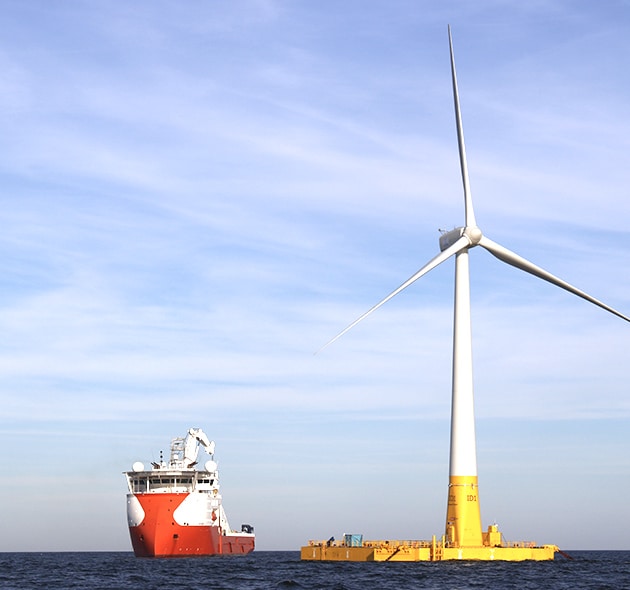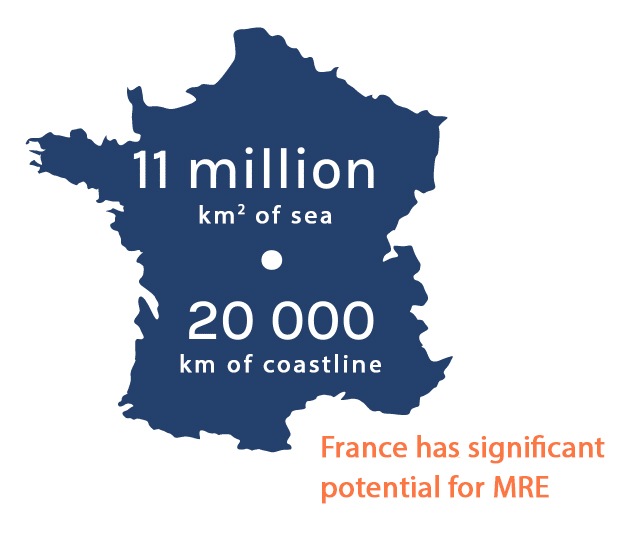Marine Renewable Energy's role in the energy transition
Today, the implementation of the energy transition leads to the active search for solutions.
"A major acceleration in the development of Marine Renewable Energy (MRE) is underway, from installed and floating wind power, to the emergence of new competitive MRE technologies."

In a broad sense, MRE covers all technologies enabling electricity to be produced from offshore resources such as wind (installed or floating wind power), wave, tidal, temperature gradient or sun (floating photovoltaics).
The plurality of existing technologies and their heterogeneous level of maturity opens up multiple development possibilities ranging from simulation, to small-scale then full-scale tests and today even to the first commercial projects for the offshore wind sector.
Development objectives of MRE
In France
The Multi-Annual Energy Program (PPE) is already planning call for tender volumes of 3.75 GW for installed and floating wind power in France between 2019 and 2023 then at least 1 GW/year to from 2024. An upward review of these objectives was recently announced with a volume of 2 GW/year from 2025.
The “2050 energy futures” study carried out by RTE and published at the end of 2021, which is based on the elements of the National Low Carbon Strategy, estimates according to scenarios from 22 to 62 GW of offshore wind power in 2050 and from 0 to 3GW of tidal power and other MRE.
In Europe
With the European Green Deal, the European Union sets targets to reduce net carbon emissions by at least 55% by 2030 compared to 1990 and to become a neutral continent by 2050.
In this context, the overall objective for the share of renewable energy sources in the energy mix is increased to 40% in 2030. The implementation of these objectives, according to Wind Europe, involves the deployment of 79 GW of offshore wind by 2030 and 300 GW by 2050 compared to 16 GW installed at the end of 2021.

Objective : 40% renewable energies in 2030 in the European energy mix
Offshore wind power in Europe:
• End of 2021: 16 GW installed
• 2030 objective: 79 GW
• 2050 objective: 300 GW
Sectors
The energy transition is leading to a major acceleration in the development of installed and floating wind power, as well as numerous initiatives aimed at bringing about new competitive Marine Renewable Energy (MRE) technologies.
The function of offshore test sites in support of these technologies must be defined differently for the different sectors, according to their specific needs.
Installed wind turbine
With around 50 GW of installed capacity worldwide at the end of 2021, installed wind power has reached the stage of commercial maturity. Innovation is essentially incremental. The testing and certification of new turbine models is already underway in Europe (Osterild Wind Turbine Test Field in Denmark, Port of Rotterdam in the Netherlands).
Floating wind turbine
Floating wind power has progressed in a dozen years from the stage of the first prototypes to the stage of commercial calls for tenders. Several pilot farms have been put into service in recent years, notably in Europe with Hywind Scotland (UK), WindFloat Atlantic (Portugal) and Kincardine (UK). In France, three pilot farm projects are in pre-construction/construction in the Mediterranean and a fourth is in the engineering phase in Southern Brittany. These initiatives constitute world firsts, confirming the place that France wishes to take in this technology. The dazzling development of this very innovative sector must absolutely be supported by massive research, development and innovation efforts, in order to continually improve the competitiveness of the sector and promote its socio-environmental integration.
Other EMR sectors: tidal turbine, wave energy, offshore hydrogen, floating photovoltaics, etc.
The other EMR sectors are at more upstream stages of development, with a still very broad technological spectrum. However, interesting milestones have been reached in recent years and there is real potential for testing of these technologies, particularly tidal turbines which are currently developing pre-commercial projects.